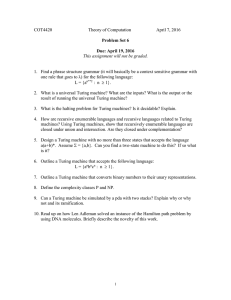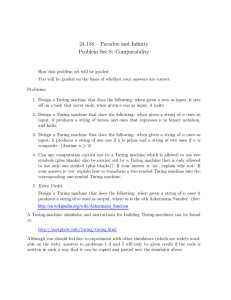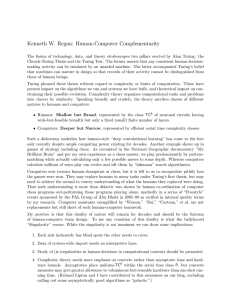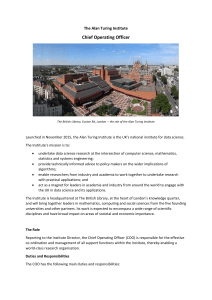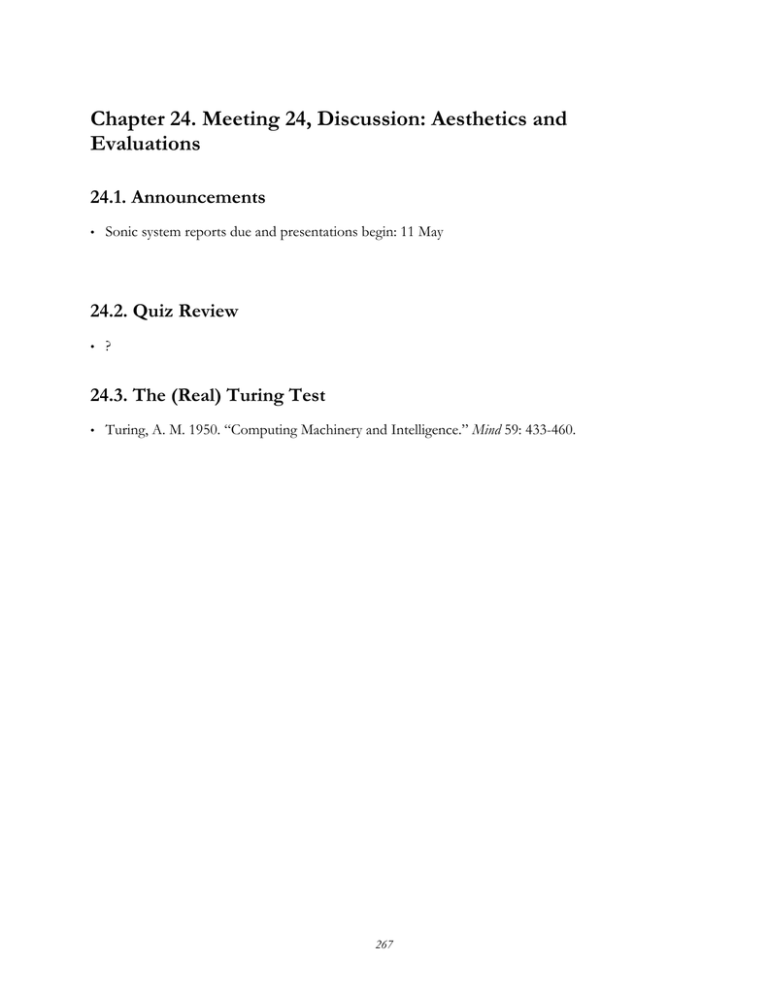
Chapter 24. Meeting 24, Discussion: Aesthetics and
Evaluations
24.1. Announcements
•
Sonic system reports due and presentations begin: 11 May
24.2. Quiz Review
•
?
24.3. The (Real) Turing Test
•
Turing, A. M. 1950. “Computing Machinery and Intelligence.” Mind 59: 433-460.
267
© Oxford University Press. All rights reserved. This content is excluded from our
Creative Commons license. For more information, see http://ocw.mit.edu/fairuse.
268
•
A test of human and computer indistinguishability
96-G2K
Compu
ter
Computer
?
Image by MIT OpenCourseWare.
•
Based on a party game in which an interrogator attempts to distinguish the gender of two human
agents
•
Through removing biases (sound, visual presence), and focusing on language alone, can a machine
be indistinguishable from a human?
•
Multiple tests can be averaged; after 5 minutes of conversation correct identification must be less
than 70 percent
•
Claim only of achieving thinking, not intelligence
•
Functional rather than structural indistinguishability (2000, p. 429)
269
•
Deception is permitted: mathematical questions can take longer, or fake mistakes
•
Is human-like conversation the sole determinate of thinking?
24.4. The Eliza Effect
•
Humans too easily associate humanity with machines
•
Eliza in emacs: shift + escape; enter “xdoctor” and return
24.5. Other Tests: The John Henry Test
•
The John Henry Test (JHT): a test of verifiable distinguishability between human and machine
•
Other examples?
24.6. Other Tests: The Turing Hierarchy
•
Steven Harnad
•
Total Turing Test: full physical and sense based interaction
•
T4: internal microfunctional indistinguishability
•
T5: microphysical indistinguishability, real biological molecules
•
t1: toy tests: subtotal fragments of our functional capacity (Harnad 2000, p. 429)
•
The TT is predicated on total functional indistinguishability; anything less is a toy
24.7. A Little Turing Test
•
Hofstadter, D. R. 1979. Gödel, Escher, Bach: an eternal golden braid . New York: Vintage.
•
The little turing test (1979, p. 621)
270
© Vintage Books. All rights reserved. This content is excluded from our Creative
Commons license. For more information, see http://ocw.mit.edu/fairuse.
271
•
Is this a Turing Test?
24.8. A (Kind of) Turing Test
•
Kurzweil, R. 1990. The Age of Intelligent Machines. Cambridge: MIT Press.
•
“The essence of the Turing Test is that the computer attempts to act like a human within the
context of an interview over terminal lines. A narrower concept of a Turing test is for a computer
to successfully imitate a human within a particular domain of human intelligence. We might call
these domain-specific Turing tests. One such domain-specific Turing test, based on a computer’s
ability to write poetry, is presented here.” (1990, p. 374)
•
28 question “poetic Turing test” administered to 16 human judges; 48 percent correct overall
•
Cybernetic Poet
http://www.kurzweilcyberart.com/poetry/rkcp_akindofturingtest.php
•
“Music composed by computer is becoming increasingly successful in passing the Turing test of
believability. The era of computer success in a wide range of domain-specific Turing tests is
arriving.” (1990, p. 378)
•
Kurzweil and Kapor Long Bet: 20,000 that a machine will pass the Turing Test by 2029
•
Is there a narrower concept of a Turing Test?
24.9. A Musical Turing Test
•
Compare chants created by computer and by humans
272
© source unknown. All rights reserved. This content is excluded from our Creative
Commons license. For more information, see http://ocw.mit.edu/fairuse.
•
Is this a Turing Test?
•
How would this test be different if the music was performed by humans?
24.10. Musical Turing Test Archetypes
•
Musical Directive Toy Test (MDtT)
•
Musical Output Toy Test (MOtT)
•
The problem of musical judgements
•
Music is not natural language
•
We have aesthetic expectations for human and computer music
•
All executed tests report a win for the computer
•
Does success of a MDtT or a MOtT offer a sign of system design success?
•
Does aesthetic success suggest system design success?
273
24.11. Discrimination Tests
•
Blind comparison of musical outputs
•
Often material used to create the music is used as part of the test
•
All listening test are bound by musical judgements
24.12. Cope’s MOtTs
•
Cope does not associate these test directly with the TT
•
Compares EMI generated Mozart with Mozart
•
1992 AAAI conference conducted a test with 2000 visitors, claiming “absolutely no scientific
value” but claims that “machine-composed music has some stylistic validity”
•
Compares virtual music to real music in The Game
•
Many have used Cope’s music or related tests as examples of musical TTs where the machine
wins
24.13. Machine Authorship in Generative Music Systems
•
Is the machine responsible for the musical output?
•
Is the test testing the machine at all?
24.14. Aesthetic Intention in Generative Music Systems
•
The intentional fallacy: the idea that understanding the artist’s intention is necessary for evaluating
a work (Beardsley 1946)
•
Is intention required to make music?
•
Can authorship be given to things that do not have intention?
24.15. Listening
•
Listening: David Soldier, “The Birth of Ganesha,” Elephonic Rhapsodies, 2004
274
•
Elephants trained and directed in improvisation with instruments
24.16. Naughtmusik
•
Soldier, D. 2002. “Eine Kleine Naughtmusik: How Nefarious Nonartists Cleverly Imitate Music.”
Leonardo Music Journal 12: 53-58.
•
Genuine music requires composers with intent
•
Naughtmusik: nonart sounds, composers without intent
•
An Adapted Turing Test: can human judges detect naughtmusik?
•
The Tangerine Awkestra: children 2 to 9, produce sounds using instruments they do not know
how to play, recorded in a studio; listened to free jazz of Ornette Coleman and others
•
5 sophisticated adults: 5 of 8 trials led to correct identification: not iron-clad
•
Thai elephant orchestra
•
“There is something out there that looks, sounds, feels, smells like music, but isn't” (2002, p. 58)
24.17. Listening
•
The People’s Choice Music: with Vitaly Komar and Alex Melamid
•
Survey given to 500 Americans
•
Survey responders had no intent; the works were created without individual intent, and thus no
creative decision making was involved
•
Listening: David Soldier, The Peoples Choice, 2002
275
Courtesy of Dave Soldier. Used with permission.
24.18. Authorship Matters
•
Humans are still ultimately responsible for machine creations
•
The designation of author is a special designation, granted only by humans
276
•
Authorship does not require intention: what does it require?
277
MIT OpenCourseWare
http://ocw.mit.edu
21M.380 Music and Technology: Algorithmic and Generative Music
Spring 2010
For information about citing these materials or our Terms of Use, visit: http://ocw.mit.edu/terms.





